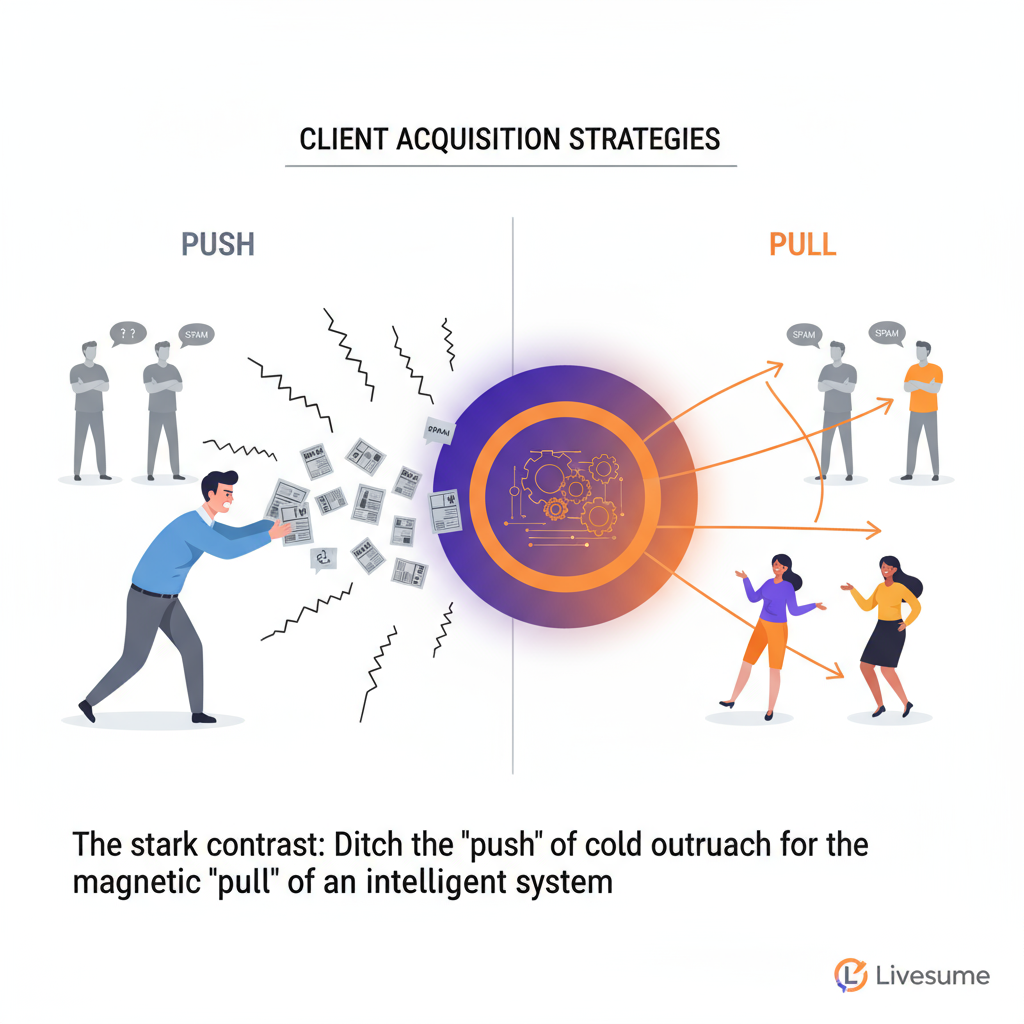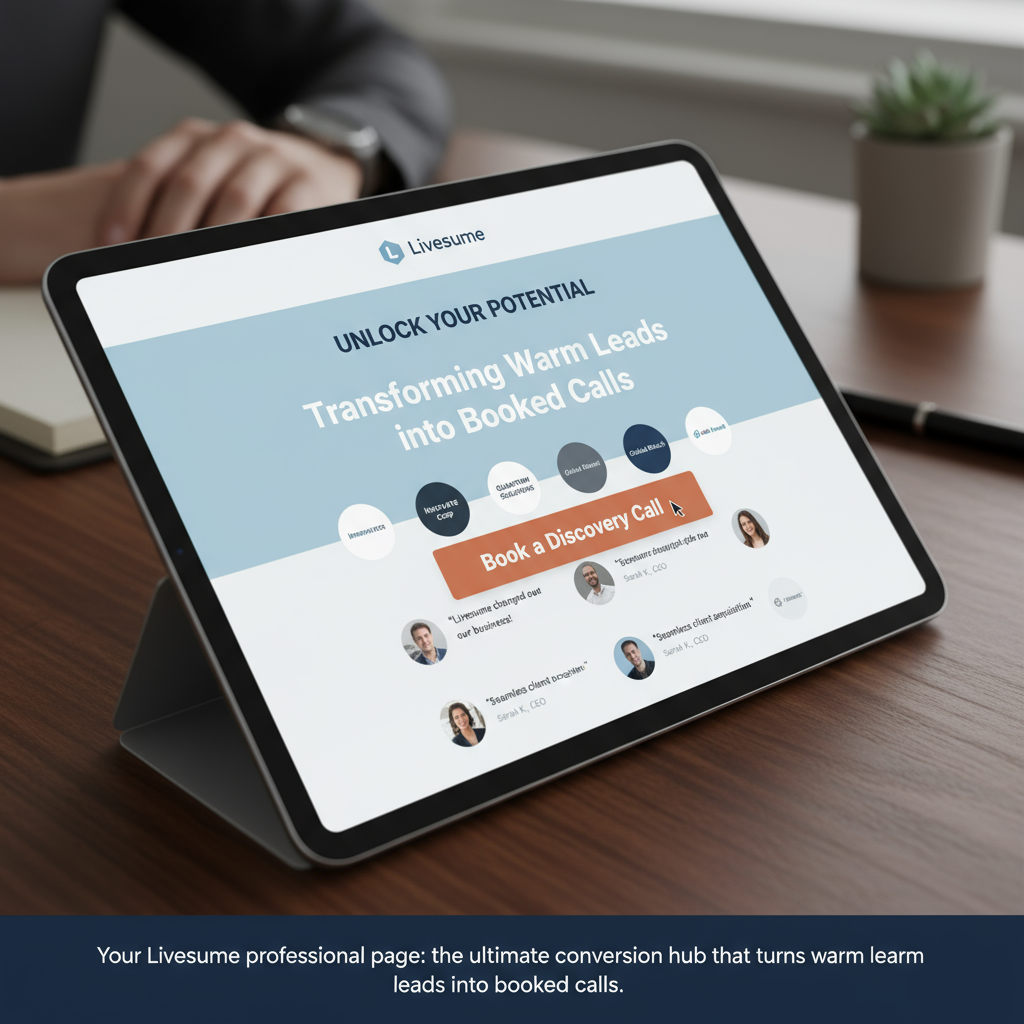You're great at what you do, but your calendar is a rollercoaster. One month you're buried in client work, the next you're hunting for the next project, hammering out cold emails that get lost in the noise. What if you could flip the script entirely? Stop chasing clients and build a simple, semi-automated system that pulls high-quality leads to you, ready to talk business. This isn't about "personal branding" fluff; it's about engineering a machine that showcases your expertise and filters for your ideal clients, so you can focus on the work you love.
Key Takeaways
- Shift from "Push" to "Pull": Ditch the high-effort, low-return cold outreach grind. We'll show you how to create an authority platform that makes ideal clients seek you out.
- Automate with an AI-Powered Content Engine: Learn to use AI tools like Perplexity and Opus Clip to create and repurpose a month's worth of expert content from a single core idea, saving you dozens of hours.
- Systemize Nurturing: Connect with prospects authentically without living in your inbox. We’ll map out how to use simple automation to build relationships at scale.
- Convert with a Central Hub: Your system needs a destination. A powerful professional page acts as the final conversion point, turning warm leads into booked calls.

Why Your Old Client Acquisition Tactics Are Failing
Let's be honest, the cold outreach playbook is broken. Inboxes are saturated with generic, "AI-personalized" messages that everyone sees right through. Relying on freelance marketplaces is a race to the bottom on price, and constantly networking can feel like a full-time job. The diminishing returns are real.
Before, you might have spent 10 hours a week on LinkedIn outreach to land one qualified meeting. That’s a grind. A "Client-Pull" system changes the equation. After setting it up, you might spend just 2 hours a week creating one core piece of content, and the system passively generates two or three qualified inbound leads. That's not just more efficient; it's more sustainable.
The 3-Stage "Client-Pull" System Framework
This isn't just a list of tactics. It's a cohesive system where each part feeds the next. Think of it as an assembly line: you create a raw material (your expertise), refine it, and deliver a finished product (a paying client).
Stage 1: The AI-Powered Content Engine (Create)
The goal here isn't to become a full-time creator. It's to efficiently translate your expertise into public-facing assets that prove you can solve your clients' problems. Stop staring at a blank page wondering what to post.
- Step 1: Uncover Pain Points with AI. Your best content ideas come directly from your clients' mouths. Use an AI research tool like Perplexity AI to act as your analyst. Instead of guessing, feed it a prompt like: "What are the top 3 operational challenges for Series B SaaS companies trying to scale their engineering teams in 2025?" It will synthesize recent articles, forum discussions, and reports into a tight summary of real-world problems.
- Step 2: Create One "Pillar" Piece of Content. Based on that research, create one valuable, long-form asset. This could be a 15-minute webinar, a detailed case study, or even a recorded interview. Don't overthink the production value; the quality of your ideas is what matters.
- Step 3: Atomize with Content Repurposing AI. Now, feed that pillar content into an AI tool like Opus Clip or Vidyo.ai. These tools will automatically identify the most compelling hooks and soundbites, turning your single recording into 10-15 short-form video clips, quote cards, and text posts formatted for LinkedIn, Twitter, and email. You just created a month of content in about an hour.
This is your first transformation: from a content creator struggling for ideas to a strategic operator with an efficient, AI-driven production system.

Stage 2: The Nurture Automation Loop (Connect)
Okay, you have content. Now what? You need a system to capture interest and build trust without manually replying to every single comment or "like."
Your goal is to move people from being passive observers to active subscribers on a platform you own—like a newsletter. Platforms like Substack or Beehiiv are perfect for this.
Here’s a simple automation sequence:
- The "Signal" Post: At the end of your social posts, instead of a vague "what are your thoughts?", use a clear call-to-action that invites engagement, like: "I created a one-page checklist for auditing your tech stack based on this. Comment 'checklist' below and I'll send it over."
- The Automated Nudge: While you can do this manually at first, you can also use tools or a virtual assistant to handle the fulfillment. The message shouldn't just be a link. It should be a conversation starter: "Hey [Name], here's that checklist. I'm curious, what's the biggest challenge you're facing with [topic] right now?"
- The Bridge to Your Hub: The checklist or resource itself should live on your Livesume landing page or be part of your newsletter welcome series, guiding them into your ecosystem.
Overwhelmed by the Content Hamster Wheel?
Stop guessing what your clients want to hear. Use Livesume's AI Assistant to brainstorm a month's worth of "thought leadership" topics in under 10 minutes based on your ideal client's pain points. Turn insights into authority.
Try the AI Assistant
Stage 3: The High-Conversion Asset (Close)
All roads in your system should lead to one place: a central hub that’s designed to convert a warm lead into a booked call. A messy LinkedIn profile or a generic website won't cut it. This is where your authority is crystallized.
Your conversion asset isn't just a resume; it's a sales page for your services. A live resume or professional page on Livesume is built for this. It should consolidate:
- Your Core Value Proposition: A sharp, one-sentence explanation of the result you deliver. (e.g., "I help fintech startups cut their customer acquisition costs by 30% through scalable marketing systems.")
- Social Proof: Testimonials, case studies, and logos of clients you've helped.
- Your "Pull" Content: Embed your best webinar, link to your top articles, or showcase your checklist. You're showing, not just telling.
- A Clear Call-to-Action: A "Book a Discovery Call" link that integrates with your calendar. No friction.
Before, a prospect might see your post, visit your profile, and leave. Now, they see your post, get a valuable resource, and land on a page that clearly explains how you can solve their exact problem. It's the difference between a dead end and a guided path to a sales conversation.

FAQ: Building Your Client-Pull System
How do I get consulting clients without cold calling?
By building a "pull" system. Create valuable content that addresses your ideal client's specific pain points. Share it on platforms where they spend their time (like LinkedIn) and use it to drive them to a newsletter or a professional page where they can learn more and book a call. You're attracting, not chasing.
What is the best way to attract high-paying consulting clients?
Demonstrate your expertise, don't just claim it. High-paying clients buy outcomes, not services. The best way to attract them is by creating "thought leadership" content (webinars, in-depth articles, case studies) that showcases your unique perspective and proves you can solve their expensive problems.
Is LinkedIn outreach still effective for consultants?
It's effective for targeted research and relationship-building, not for mass lead generation. Use it to connect with a small number of ideal clients to validate your ideas or start conversations. But your primary focus should be on posting valuable content that pulls in a wider audience, rather than pushing DMs one by one.
How can I automate my lead generation as a solo consultant?
Focus on semi-automation. Use AI tools like Opus Clip to automate content repurposing. Set up a simple email nurture sequence in a tool like Beehiiv for new subscribers. The goal isn't 100% automation; it's to automate the repetitive tasks so you can focus on the high-value human interactions, like sales calls and client work.
How do you create a "thought leadership" content strategy?
Start with one core problem your clients face. Dedicate a month to creating content around that single theme. Week 1: A pillar piece like a webinar. Weeks 2-4: The repurposed short-form clips, text posts, and a summary email to your newsletter. This focused approach establishes you as the go-to expert on that specific topic.
What does a modern consultant's tech stack look like?
It's leaner than you think. You need: 1) An AI research tool (Perplexity). 2) A content repurposing tool (Vidyo.ai). 3) A newsletter platform (Substack/Beehiiv). 4) A central conversion hub (your Livesume website). 5) A calendar scheduler (Calendly). That’s it.
Turn Your System into a Predictable Pipeline
You don't need to become a marketing expert to get off the outreach rollercoaster. You just need a system. Here’s how to start this week:
- Audit Your Expertise: Identify the top 3 questions prospects always ask you. These are your first content pillars.
- Choose Your Tools: Pick one AI research tool and one content repurposing tool to start. Don't get overwhelmed.
- Build Your Destination: Before you post anything, set up your conversion asset. Create your Livesume page. It's the most crucial step—it ensures your traffic has a place to go and a way to convert.
By shifting your focus from chasing leads to attracting them, you build a more profitable, sustainable, and enjoyable consulting business. Stop hustling. Start building your system today.